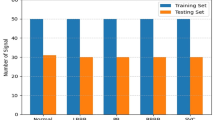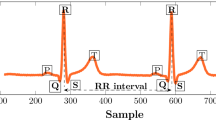Abstract
New industrial applications call for new methods and new ideas in signal analysis. Wavelet packets are new tools in industrial applications and they have just recently appeared in projects and patents. In training neural networks, for the sake of dimensionality and of ratio of time, compact information is needed. This paper deals with simultaneous noise suppression and signal compression of quasi-harmonic signals. A quasi-harmonic signal is a signal with one dominant harmonic and some more sub harmonics in superposition. Such signals often occur in rail vehicle systems, in which noisy signals are present. Typically, they are signals which come from rail overhead power lines and are generated by intermodulation phenomena and radio interferences. An important task is to monitor and recognize them. This paper proposes an algorithm to differentiate discrete signals from their noisy observations using a library of nonorthonormal bases. The algorithm combines the shrinkage technique and techniques in regression analysis using Shannon Entropy function and Cross Entropy function to select the best discernable bases. Cosine and sine wavelet bases in wavelet packets are used. The algorithm is totally general and can be used in many industrial applications. The effectiveness of the proposed method consists of using as few as possible samples of the measured signal and in the meantime highlighting the difference between the noise and the desired signal. The problem is a difficult one, but well posed. In fact, compression reduces the level of the measured noise and undesired signals but introduces the well known compression noise. The goal is to extract a coherent signal from the measured signal which will be “well represented” by suitable waveforms and a noisy signal or incoherent signal which cannot be “compressed well” by the waveforms. Recursive residual iterations with cosine and sine bases allow the extraction of elements of the required signal and the noise. The algorithm that has been developed is utilized as a filter to extract features for training neural networks. It is currently integrated in the inferential modelling platform of the unit for Advanced Control and Simulation Solutions within ABB’s industry division. An application using real measured data from an electrical railway line is presented to illustrate and analyze the effectiveness of the proposed method. Another industrial application in fault detection, in which coherent and incoherent signals are univocally visible, is also shown.
Similar content being viewed by others
References
P. Terwiesch, Industrial modeling and control challanges related to electrical rail vehicles, in Proc. European Control Conference ECC’99, 1999.
S. Liu, An Adaptive Kalman filter for dynamic estimation of harmonic signals, in Proceedings-IEEE 8th International Conference on Harmonics and Quality of Power, Athens 1998.
B. Perunicić, M. Mallini, Z. Wang, and Y. Liu, Power quality disturbance detection and classification using wavelets and artificial neural networks, in Proc. 8th IEEE International Conference on Harmonics and Quality of Power, Athens 1998.
P. Terwiesch, S. Menth, and S. Schmidt, Analysis of Transients in Electrical Railway Networks Using Wavelets, IEEE Trans. on Industrial Electronics, 1998, 45(6): 955–959.
P. Mercorelli, M. Rode, and P. Terwiesch, A Wavelet Packet Algorithm for Online Detection of Pantograph Vibrations, in Proc. 9th IFAC Int. Symp. on Control in System Transportation 2000, Braunschweig, 2000.
P. Mercorelli, M. Rode, and P. Terwiesch, System and Methodology for Dominant Frequency Detection by Using a Set of Trigonometric Wavelet Functions, Patent N 7759 in Patentamt ABB Corporate Research Mannheim. Code in the German Paten Office 10 25 89 21. 6, 2001.
P. Mercorelli and P. Terwiesch, A Black Box Identification in Harmonic Domain, VDE European Transactions on Electrical Power, 2003, 13(1): 29–40.
P. Terwiesch and P. Mercorelli, A Local Feature Extraction Using Biorthogonal Bases for Classification of Embedded Classes of Signals, in Proc. 14th Int. Symp. on Mathematical theory of networks and systems (MTNS 2000), Perpignan, France, 2000.
R. R. Coifman and M. V. Wickerhauser, Entropy based algorithm for best basis selection, IEEE Trans. Inform. Theory, 1992, 32: 712–718.
N. Saito and Ronald R. Coifman, Local discriminant bases, in Mathematical Imaging: Wavelet Applications in Signal and Image Processing II, Proc. SPIE, 1994, 2303.
Q. Zhang, Using Wavelet Network in Nonparametric Estimation, IEEE Transaction on Neural Networks, 1997, 8(2): 227–236.
J. M. Shapiro, Image coding using the embedded zerotree wavelet algorithm, in Proc. SPIE Conf. on Mathematical Imaging: Wavelet Applications in signal and Image Processing (ed. by A. F. Laine), 1992, 2034: 180–193.
R. A. De Vore, B. Jawerth, and B. J. Lucier, Image compression through wavelet transform coding, IEEE Trans. Inform. Theory, 1992, 38(2): 719–746.
M. V. Wickerhauser, High-resolution still picture compression, Digital Signal Processing: A Review Journal, 1992, 2(4): 204–226.
D. L. Donoho, Wavelet shrinkage and W. V. D.: a 10-minute tour, in Progress in Wavelet Analisis and Applications, Editions Frontieres, B. P. 33, 91192 Gif-sur-Yvette Cedex France, 1993, 109–128.
D. L. Donoho and I. M. Johnstone, Ideal spatial adaptation by wavelet shrinkage, Preprint, Dept. of Statistics, Stanford University, Stanford, CA, Jun., 1993.
S. Mallat and Z. Zhang, Matching Pursuit with Time-Frequency Dictionaries, IEEE Trans. on Signal Processing, 1993.
N. Saito, Simultaneous Noise Suppression and Signal Compression using a Library of Orthonormal Bases and the Minimum Description Length Criterion, Wavelets in Geophysics (ed. by E. Foufoula-Georgiou and P. Kumar), Academic Press, 1994.
I. Daubechies, Ten Lectures on Wavelets, Publisher Society for Industrial and Applied Mathematics, Philadelphia (Pennsylvania), 1995.
P. Auscher, G. Weiss, and M. V. Wickerhauser, Wavelet-A Tutorial in Theory and Applications, in Local sine and cosine bases of Coifman and Meyer and the construction of smooth wavelets (ed. by C-K Chui), Academic Press, Boston, 1992, 237–256.
A. Benveniste, A. Juditscky, B. Delyon, Q. Zhang, and P. G. Glorenee, Wavelets in Identification, in Proc. SYSID’94 10th IFAC Symp. Syst. Identification, Copenhagen, 1994.
S. Mallat and Z. Zhang, Matching pursuit with time-frequency dictionaries, Technical Report 619, New York University, Computer Science Departiment, 1993.
P. Mercorelli and A. Frick, Noise Level Estimation Using Haar Wavelet Packet Trees for Sensor Robust Outlier Detection, Selected paper in IEE The 2006 International Conference on Computational Science and its Applications (ICCSA 2006 Glasgow), Series: Lecture Note in Computer Sciences, Springer-Verlag publishing, 2006.
Author information
Authors and Affiliations
Corresponding author
Rights and permissions
About this article
Cite this article
Mercorelli, P. Denoising and Harmonic Detection Using Nonorthogonal Wavelet Packets in Industrial Applications. Jrl Syst Sci & Complex 20, 325–343 (2007). https://doi.org/10.1007/s11424-007-9028-z
Received:
Revised:
Issue Date:
DOI: https://doi.org/10.1007/s11424-007-9028-z




